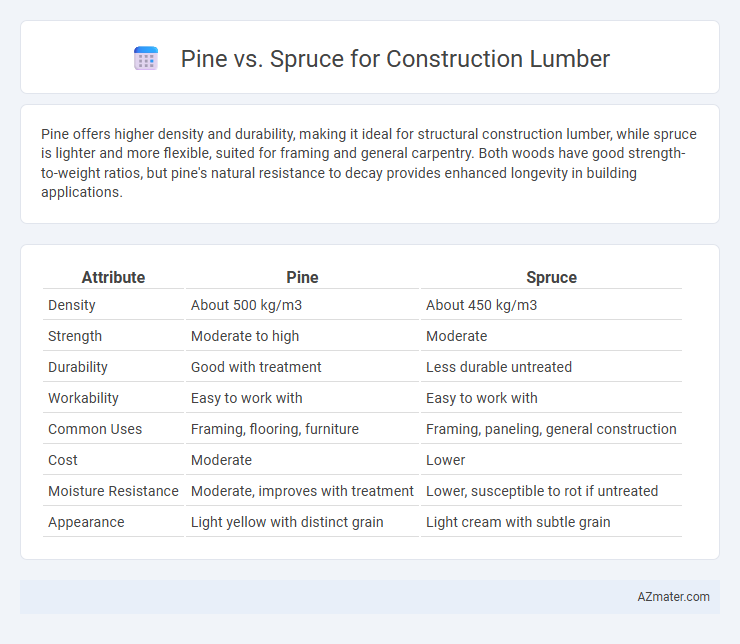Pine offers higher density and durability, making it ideal for structural construction lumber, while spruce is lighter and more flexible, suited for framing and general carpentry. Both woods have good strength-to-weight ratios, but pine's natural resistance to decay provides enhanced longevity in building applications.
Table of Comparison
| Attribute | Pine | Spruce |
|---|---|---|
| Density | About 500 kg/m3 | About 450 kg/m3 |
| Strength | Moderate to high | Moderate |
| Durability | Good with treatment | Less durable untreated |
| Workability | Easy to work with | Easy to work with |
| Common Uses | Framing, flooring, furniture | Framing, paneling, general construction |
| Cost | Moderate | Lower |
| Moisture Resistance | Moderate, improves with treatment | Lower, susceptible to rot if untreated |
| Appearance | Light yellow with distinct grain | Light cream with subtle grain |
Introduction: Pine vs Spruce in Construction
Pine and spruce are commonly used softwoods in construction lumber, each offering distinct properties suited for structural applications. Pine typically features higher resin content and durability, making it ideal for framing and load-bearing structures, while spruce is valued for its lightweight strength and ease of handling. Selecting between pine and spruce depends on factors such as environmental exposure, required strength, and cost-effectiveness in building projects.
Wood Properties and Structural Strength
Pine and spruce both serve as popular choices for construction lumber due to their favorable wood properties and structural strength. Pine typically boasts a higher density and greater load-bearing capacity, making it suitable for heavy structural applications like beams and joists. Spruce offers a lighter weight and consistent grain, providing easier workability and good strength for framing and general construction purposes.
Growth Patterns and Sustainability
Pine trees generally exhibit faster growth rates compared to spruce, making pine lumber more readily renewable for construction purposes. Spruce wood often comes from older, slower-growing trees, resulting in tighter grain patterns that contribute to structural strength yet a longer replenishment cycle. Sustainable forestry practices prioritize harvesting pine for its rapid regrowth while managing spruce populations to maintain ecosystem balance and long-term resource availability.
Workability and Ease of Processing
Pine lumber offers superior workability due to its softer texture, making it easier to cut, shape, and fasten with standard tools compared to spruce. Spruce tends to be slightly harder and more brittle, which can require more effort and precision during processing but provides greater dimensional stability in finished products. Both woods respond well to finishing, but pine's uniform grain enhances smooth sanding and better paint or stain absorption.
Durability and Resistance to Decay
Pine lumber offers moderate durability with a natural resistance to decay, making it suitable for interior construction but requiring treatment for prolonged outdoor use. Spruce lumber is less durable and more prone to decay without preservative treatment, often favoring indoor applications or temporary structural use. Both woods benefit from chemical preservatives to enhance longevity and resistance to fungal decay in demanding construction environments.
Cost Comparison and Availability
Pine lumber is generally more affordable and widely available than spruce, making it a cost-effective choice for construction projects. Spruce offers a slightly higher strength-to-weight ratio but often comes at a premium price due to limited regional availability. Builders frequently select pine for large-scale construction due to its consistent supply and lower market cost.
Finishing and Aesthetic Appeal
Pine lumber offers a warm, yellowish tone with prominent grain patterns that accept stains and paints well, making it ideal for finished interior applications requiring a rustic or traditional aesthetic. Spruce, characterized by a lighter, creamy color and a finer, more uniform grain, provides a smoother surface that excels with clear finishes and pale stains, enhancing modern or minimalist designs. Both woods are softwoods suitable for construction, but pine's richer texture tends to show nail holes and dents more prominently, influencing finishing choices for longevity and visual appeal.
Environmental Impact and Eco-Friendliness
Pine lumber generally has a lower environmental impact than spruce due to its faster growth rate, which allows for quicker carbon sequestration and more sustainable harvesting cycles. Pine forests often require fewer pesticides and fertilizers compared to spruce plantations, enhancing their eco-friendliness. Both types of wood are renewable, but pine's superior regrowth efficiency and widespread availability make it a preferred choice for environmentally-conscious construction projects.
Regional Preferences in Lumber Selection
In North America, pine species like Eastern White Pine dominate construction lumber in the Northeast due to their ease of workability and availability. Spruce, particularly Engelmann and Sitka varieties, is preferred in the Pacific Northwest for its strength-to-weight ratio and abundance in local forests. Regional climate and forest ecology largely influence these preferences, with pine favored in drier hardwood-mixed regions and spruce in wetter, conifer-dominant areas.
Conclusion: Choosing the Optimal Wood for Construction
Pine and spruce both offer valuable qualities for construction lumber, with pine known for its durability and resistance to decay, making it ideal for structural applications. Spruce provides a lighter weight and consistent strength, which is beneficial for framing and general construction use. Selecting the optimal wood depends on specific project requirements such as load-bearing capacity, exposure conditions, and budget considerations.

Infographic: Pine vs Spruce for Construction Lumber
 azmater.com
azmater.com